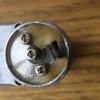Thank you Mac. What's really ironic is that I have started to run TSC's now. The "T" part is the hard part with the twisted wire. Yep, my ID has bloated to a lofty 2.5mm in a single coil setup like this:
View attachment 472410
It produces. I believe my experience indicates to me that in a 22mm atty that doesn't allow a coil setup like that because of a centerpost, a dual coil setup of 2.0mm ID is my sweet spot. In a smaller atty, say 18-14 mm a 1.5ish mm ID coil did it but in my latest favorite atty - the stumpy, a 2.5mm ID coil with twisted (yes, me using twisted wire) outruns duals in fullness, warmth and quantity of vapor because that big fat coil sits directly in line with and about 1/2" from my mouth. Wide open AFC on both sides. It really is an amazing vape - even at 0.8 ohms. I don't see myself going back to duals now that the simplicity of a single coil can provide such a high performance vape

Congrats supe, as often I've mentioned twisted's were my preferred vape in the background for the better part of two years as I evaluated clearomizer strain build methods and talked up tension for new vapers. As it happens my first authentic, a gold Trident ridin' a Sentinel/M1, is sporting a single like yours. Revived my still favorite reference standard device for tobacco just today. You must have radar. Yes sir, you can get more production out of them. For some juices, I still favor it. Hard to get the twist pitch consistent enough to attempt a contact coil. Even then 2/3 go hot with mixed oxidation results as your pic suggests but a vape I certainly still strive for one once in a while. Whenever I got one stable enough it'd go on the ZNA. And I'm with you on the preference for twisted singles. Get better results generally with straight wire t.m.c.'s goin' dual.
Good luck on this new horizon.

